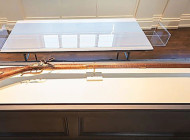Op-Ed By Steven Miller
Having long studied how American museums remove (deaccession) collections, I now believe that everything they own can be bought. To be sure, price tags don’t appear on exhibited paintings, dinosaur fossils or antique artifacts. But given the unremitting and exploding practice of commercially discarding things, anyone desiring what they see displayed or know lurks in museum storage should, in the United States at least, feel comfortable making a purchase offer.
My smartass assessment of the open market for museum collections is hardly a joke. I have been in the museum field for nearly 50 years as a director, curator, trustee, administrator, consultant, author, critic and teacher of museum studies. I have written more than anyone about museum deaccessioning and have authorized the practice a few times during my career. My view of it has evolved to the point outlined in this short opinion piece.
Most museums in the United States are private. Unless ownership restrictions exist for particular objects, collections may be dealt with as a museum wishes. This includes getting rid of them in whatever manner desired. The vast majority of museums in the rest of the world are government entities and their collections seem to be rarely removed in any official capacity. My experience is limited to America.
Over the years, museums in the United States have periodically sold art, historic artifacts and scientific specimens. Sometimes unwanted collections are given to other museums but that is infrequent. Today, selling museum collections is a common occurrence. It happens regularly and often with great fervor. The pace will increase. The practice has essentially created a new commercial market.
A few recent examples illustrate the popularity of museum collection selling and how wide the variety is these days. A rare stellar painting by the abstract expressionist Mark Rothko that was a gift to the San Francisco Museum of Modern Art by the artist in 1962 went on the auction block in 2019. If you like antique cars, perhaps you saw the Pennsylvania Historical and Museum Commission sent a 1902 Gardner-Serpollet steam auto out the door in 2019. For those who love gems and minerals, 15,000 were about to be sold by Philadelphia’s Academy of Natural Sciences in 2006 until that institution was taken over by Drexel University. The Historical Society of Pennsylvania recently sold a huge collection of medals and medallions relating commemorations of and about George Washington.
As noted, when collections are removed from museums it is called deaccessioning. This is the $25 word for a policy, process and outcome usually set and approved by museum governing bodies. It is supported by major museum profession membership organizations. The American Alliance of Museums, the American Association for State and Local History and the American Association of Art Museum Directors all have statements approving and guiding the practice as do smaller regional museum membership groups. Most museums now boast deaccession policies. They are usually contained in management documents.
To be clear, the collections I am referring to are objects legally owned by museums. The proof and clarity of this is found in museum documentation of a gift, donation or field retrieval (often the case with natural history or archaeology collections). Customarily museums convey this to the public when accession numbers are affixed to items or noted in interpretive information in exhibits, catalogs, programming materials, etc. These numbers tend to be unique to unique items.
Previously, museum collection removal, be it by sale, destruction or inter-museum transfer, was hardly made public in any organized regular fashion. That changed during the 1970s. It was loudly exposed when a couple of culture reporters in the mainstream media revealed the Metropolitan Museum of Art was “secretly” selling art to buy other art. The entire profession was embroiled in a huge debate. Various codes, instructions, directives and official museum pronouncements were promulgated to legitimize the practice.
Now accepted by the field, on occasion deaccessioning continues to be the most consistently controversial activity for American museums. Curiously, objections seem to be only voiced outside the museum world. Members of the public with an interest in museums are the ones expressing the loudest complaints. Museum employees who object tend to keep quiet for reasons of collegial camaraderie and job security. Yet, rarely has vitriol caused an attacked museum to retract a deaccession decision.
Museums often claim to be of transparent public service. That transparency assertion evaporates when it comes to allowing any meaningful public involvement with inside operations. In the United States a superficial nod to citizen participation in museums is suggested by their customary form of governance. The vast majority are private entities. Their legal guardians are self-perpetuating boards of trustees. These unpaid volunteers are to serve the best interest of the organizations they lead. On a larger scale, this structure is common with most American private charities. Consequently, most fall into a nonprofit tax exempt status designated by the United States Internal Revenue Service. Examples can include food banks, private schools, homeless shelters, hospitals, camps and the like.
As with most such charities, designated government legal watchdogs for museums and their boards are state attorneys general. The oversight is negligible unless some enormous and obvious legal violation is discovered. Consequently, museums are pretty much independent operations. This is especially the case regarding how they treat their collections.
There was a time in America when it was assumed museum collections were gathered together to be kept in perpetuity for valued purposes. Objects were evidence of whatever subject a particular museum was about. Collections were held in trust for past, present and, it was hoped, future generations. This core preservation imperative is horribly shattered when things are sold on the open market. The action results in grave multiple losses. Unless acquired by another museum, which happens rarely, items are essentially destroyed by their sale disappearance. (Ask any museum to tell you where the things they sold are now.) The catalog and other records so carefully generated and retained by museums may at best provide footnote information for scholarly researchers. Since the vast majority of museum collections are donations, the good wishes of donors are grievously violated. And, of utmost importance, the public has lost part of its once shared patrimony.
In a pretense at the aforementioned transparency notion, when museums sell collections, they tend to use auction houses. Watch their sale schedules. It is common practice to note prominent institution consignors. The wording appears in catalogs, advertisements and through various promotions both on-line and off. A museum pedigree amplifies commercial value, and it absolves the museum of accusations of nefarious secrecy.
How can I summarily pronounce all museum collections are for sale? Considering the money museums spend to safeguard what they have, promote their holdings, and the uproar that greets thefts or loss by natural elements, my claim is a bit of a stretch. No? No.
Since it became accepted as a legitimate collection management option, deaccessioning by sale has grown rapidly. I see no halt to this. Nor do I see it slowing at all, just the opposite. Moreover, the action is embraced by the three principal types of museums: art, history and science (natural history, archaeological or technological in nature).
Why are museums selling collections with such alacrity? The answer is simple. Money. Museums are very expensive places to operate. None are profitable undertakings. Generally speaking, they rely on three ways of getting financial support: individuals give money, endowment investments (if they exist) provide returns, and earned income (including the sale of collections) brings in much-needed dollars. Grants from foundations and governments are part of a mix but may not always provide a consistent reliable revenue stream.
Museum trustees are fiduciaries and as such, among other things, they need to have the nonprofit charitable organization’s financial well-being under control. In the past, trustees tended to be people with money, or they knew people with money. They were expected to contribute wealth, wisdom and work. When it came to museums, large or small, these unusual places did benefit from meaningful support from the rich. In the past, how “rich” was defined depended on the museum, where it was located, its mission, and how helpful its trustees were in those contexts.
Today, because there are many, many more charities than was the case when museums tended to be established, competition for free-will donations is crushing. Adding to the pressure, the need to meet higher museum profession standards has raised costs. And, museums rarely shrink. Boards frantically seek money but are often woefully unwilling or unable to pony it up themselves, at least not in amounts sufficient for the survival of “their” museum.
A pair of interconnected new museum realities is further contributing to museum collection removals. Museums are now seen as attractions, along the lines of amusement parks, theaters, performing arts centers, etc. To a degree this stance was caused by leading art museums when two in particular created what became known as blockbuster exhibitions. In the 1960s-70s, attendance competition was fierce between the National Gallery, Washington, DC and the Metropolitan Museum of Art, New York City. Other museums followed the lead. Suddenly what was “playing” at a local museum was as important as what was “playing” at a local cinema. This business development meant museum collections have enhanced responsibilities. Languishing in storage is unacceptable. Things now, almost literally, have a shelf life. Collections need to earn their keep. Adding to this pressure is the fact that many museum storerooms are full to overflowing. Trustees are asking why hold this stuff when it can be sold to help balance the budget, pay for much-needed capital improvements, and, most importantly, get us off the fundraising hook?
When deaccessioning was recognized as an attack on museum collections, American museum profession membership organizations scurried to address the issue. Of course, since the income for these groups comes from their members, care had to be taken not to alienate patrons. The outcome of lengthy discussions was predictably ineffectual. As already noted, museums can still pretty much get rid of things as they wish. If items are sold, the proceeds are supposed to be allocated for the purchase of new acquisitions or the direct conservation care of collections.
Other than perhaps a hired auditor, no one outside a deaccessioning museum actually checks balance sheets for how collection sale income is entered and used, especially as time goes by. Who knows what really happens. And, there are glaring instances of a total rejection of the profession codes, such as when money is used to pay down debt or financially restructure operations. There are, essentially, no draconian outcomes for an American museum that declines to abide by museum profession deaccession recommendations. If an institution has been accredited by the American Association of Museums, the worst thing that can happen is that accreditation can be rescinded. Since offending museums will readily get back in the AAM’s good graces, this circumstance is temporary.
So, how does one ask a museum to sell them a collection object? Easy, approach appropriate staff or any trustee. Staff would include collection managers, curators and directors as they are the people who work with collections most closely. An initial inquiry to these folks will usually garner a polite response that the museum does not capriciously sell things. You may receive a short talk about the importance of what is held in public trust and that deaccessioning is a rare activity. You can go right to a director or work your way up through museum employee ranks. You may be given a copy of a museum’s deaccession policy, which has usually been preapproved by the board of trustees.
If your request is declined by staff, approach a trustee or two or the board as a whole. You might want to initiate your inquiry at that level. Their response will probably echo the staff’s. However, you actually have the museum profession’s own deaccession protocols on your side. You can say you know these and use them to your advantage. You can explain that your payment will allow the museum to buy a better example of what you want. Or, your money can be used for much-needed conservation. Or, the funds can go into investments to support unanticipated acquisitions and conservation.
Remember though, money talks. The price you are willing to pay for an object may be significant enough to be greeted with enthusiasm. If not, wait and occasionally revisit the discussion, who knows.
Museums always need money. Happy Hunting!
Steven Miller’s newly released book is titled Museum Collection Ethics: Acquisition, Stewardship and Interpretation, Rowman & Littlefield Publishers, www.rowman.com; 2020; 192 pages; hardcover $65, softcover $32.




